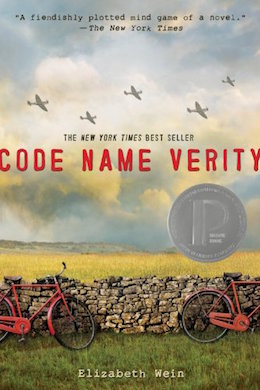For the past several years, I’ve been recommending Code Name Verity by Elizabeth Wein as the best book I’ve read in ages. Okay, it’s not fantasy, but it’s historical fiction, which is also near and dear to my heart. It takes place during World War II, and tells the story of two young British women, an intelligence agent and a pilot, and the friendship they form. The book is divided in two sections, each protagonist getting her own narrative.
At the outset we meet our first protagonist, the intelligence agent—she calls herself Queenie—as a prisoner of the German army in occupied France. Her narrative shifts between a first-person account of her harsh treatment at the hands of the Nazis, seeking to extract valuable codes from her, and a third-person recollection of her developing friendship with the pilot and sharpshooter Maddie, whom her captors inform her died when her plane crashed. Everything is ostensibly recorded in a diary cobbled together from whatever materials her captors afford her, rife with disgust at her own cowardice and collaboration.
(Major spoilers ahead.)
There’s just enough wry gallows humor in Queenie’s “diary” to make the reader suspect she’s an unreliable narrator underplaying her own strengths, but the extent to which this is true isn’t revealed until the second section in which the pilot Maddie’s voice takes over, telling the flip side of their overlapping journey.
Annnd… it’s impossible to discuss it further without spoilers, so if you haven’t read Code Name Verity, I suggest that you do so, then come back and finish reading this piece. Okay? Very good, let’s continue. In the second half of the book, we follow Maddie’s travails in occupied France, hidden and aided by members of the Resistance. When they discover that Queenie—real name Julie, code name Verity—is alive and being held by the Gestapo, together they attempt a daring rescue as prisoners are being transferred to a concentration camp.
I was absolutely unprepared for the rescue attempt to fail, especially after we’ve gotten to see Julie through Maddie’s eyes, and realize that Queenie the craven narrator of the first section is indeed a fiction, disguising a brave, daring, fiercely intelligent young woman conspiring to smuggle out intelligence information under the nose of the Gestapo. But it all goes terribly awry. No one is rescued. The sole dubious saving grace is that Julie recognizes Maddie’s distinctive racking sobs in the distance. Lighting up with joy at the realization her friend is alive, she calls out to her—one last piece of code in a sense, an inside joke from their days of flying missions together, alleged to be the dying words of Admiral Lord Nelson at the Battle of Trafalgar. “Kiss me, Hardy! Kiss me, quick!”
It’s a dreadful plea in a moment of extremity. And before her captors can force Julie onto the lorry bound for a concentration camp and the horrors of the Nazis’ program of medical experimentation, Maddie shoots her dead.
Shoots her dead.
Honestly, the first time I read this book, I was in denial. I kept waiting for the reveal, waiting to find out that the awful thing that appeared to have happened, hadn’t. It’s not that the twist was unfair, it’s just that we’re so conditioned to expect happy endings, I felt sucker-punched. And yet there’s a certain fearsome beauty and poetic elegance to the scene. I’ve written my share of tragic scenes, and I know that a reader in tears at the right moment in a narrative means I’ve done my job well.
In the final section of the book, as Maddie copes with the emotional aftermath of having killed her best friend, “Queenie’s” diary is deconstructed, and we learn that not only did she give her captors absolutely no information of value, but we discover the ways in she encoded intelligence in her diary, completely up-ending everything the reader thought he or she knew about the first section. The smuggled intelligence enables the Resistance to enact a successful sabotage and destruction of the Gestapo Headquarters in the town where Julie was held—the happy ending I expected, too late for the young woman who made it possible.
Upon finishing the book, as a writer, I wanted to reread it immediately to analyze how Elizabeth Wein pulled off such a feat of literary legerdemain. But as a reader, I just couldn’t, because it was so terrible and horrible and sad and noble and true and good, it left me gutted.
“Kiss me, Hardy! Kiss me, quick!” For the rest of your life, I promise, those words will make you cry.
 Jacqueline Carey is the author of the New York Times bestselling Kushiel’s Legacy series of historical fantasy novels, Miranda and Caliban, The Sundering epic fantasy duology, postmodern fables “Santa Olivia” and “Saints Astray,” and the Agent of Hel contemporary fantasy series. Carey lives in western Michigan.
Jacqueline Carey is the author of the New York Times bestselling Kushiel’s Legacy series of historical fantasy novels, Miranda and Caliban, The Sundering epic fantasy duology, postmodern fables “Santa Olivia” and “Saints Astray,” and the Agent of Hel contemporary fantasy series. Carey lives in western Michigan.










